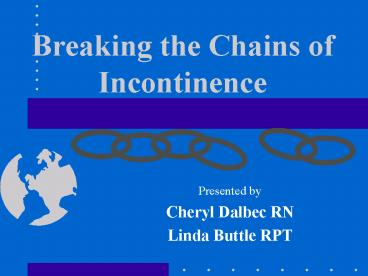Breaking the Chains of Incontinence PowerPoint PPT Presentation
1 / 28
Title: Breaking the Chains of Incontinence
1
Breaking the Chains of Incontinence
- Presented by
- Cheryl Dalbec RN
- Linda Buttle RPT
2
Urinary Incontinence
- Definition Incontinence is a condition in
- which involuntary loss of
urine - is a social or hygienic
problem - and is objectively
- demonstrable.
3
MythsPeople who are incontinent are
- Very old
- Feeble
- Senile
- Totally dependent
- No longer in control
4
Facts
- If individuals lose only one or two drops of
urine when they dont want to, thats considered
incontinence!
5
Facts
- Incontinence can affect anyone at any age of
either sex!
- 1 in 4 women - of these approximately 1/3 will
develop chronic problems. - 1 in 10 men
- 1 in 5 seniors
- 50 of those in long term care facilities.
6
Facts
- Incontinence is not an inevitable result of aging
but a potentially reversible disturbance.
- It is not a disease but a symptom of some
underlying problem such as weak pelvic muscles,
endocrine problems(Diabetes), neurological
problems(MS), injury, surgery, medications
7
Facts
- Despite the prevalence of incontinence, the
condition is highly misunderstood and
underreported. Approximately 45 of people
experiencing symptoms never report them to their
health care professional.
8
Let us now look at the different types of
incontinence and their symptoms . . . . .
9
Stress Incontinence
- Involuntary loss of urine during coughing,
sneezing, laughing or any other activities that
increase abdominal pressure.
- Loss of small to moderate amount of urine
- No loss of urine at night
- No urgency
- Voluntary frequency
10
Urge Incontinence
- Involuntary loss of urine with a strong desire to
void
- Inability to postpone voiding
- Urgency
- Frequency
- Night time voiding
11
Overflow Incontinence
- Involuntary loss of urine due to distention of
the bladder
- Hesitancy
- Straining to void
- Poor/intermittent stream
- Dribbling, frequency
- Frequent infections
- Large residual urine
- Night time voiding
12
Functional Incontinence
- The involuntary loss of urine that is a result of
factors outside the lower urinary tract such as
chronic impairments of physical and cognitive
functioning.
- Impaired mobility/dexterity
- Impaired mental function
- Psychological problems
- Environmental considerations
13
Iatrogenic Incontinence
- Involuntary urine leakage resulting from
treatment by any health care practitioner.
- Constipation
- Sedation
- Confusion
- Frequency
- Surgical procedure
- Infection
- Prolonged immobilization
14
The following are suggestions of conservative
treatments or what you can do to reduce or
eliminate the symptoms.
15
Lifestyle choices
- Reduce or eliminate caffeine
- Reduce or eliminate alcohol
- Drink 6 to 8 glasses of water daily
- Quit smoking
- Weight control
- Follow a healthy diet high in fibre
16
Exercise
- Pelvic Floor
- Abdominals
- -Recti abdominus
- -Obliques
17
Exercise
- Pelvic Floor
- Where is it?
- Why?
- How often?
- How can I do that?
18
Exercise
- Pelvic Floor Where is it?
- Between the pubic bone and the sacrum.
19
Exercise
- Pelvic Floor Why?
- These are the muscles that are stretched with
pregnancy and child birth. - These muscles are weakened by straining with
constipation. - These muscles are often forgotten- out of sight
out of mind
20
Exercise
- Pelvic Floor How often?
- Ideally exercises should be done - 100 times
a day!!!!!!
21
Exercise
- Pelvic Floor How do I do that?
- Begin in a small way lying on your back with
your knees bent - Do 5 repetitions twice a day.
- Progress to a sitting or standing position
- Gradually increase the repetitions
22
Exercise
- Pelvic Floor continued
- Incorporate these exercises into your daily
living while sitting and standing. - For example while brushing your teeth, while
stopped at a red light or watching the news
23
Exercise
- Abdominals
Obliques
Rectus
24
Exercise
- Abdominals
- Recti abdominus Obliques
25
Timed Voiding
- This is a regularly scheduled pattern of voiding
where the intervals between voiding are gradually
increased. - It reduces irritability of the bladder
- Reverses bad habits
- No longer needing to camp out by the bathroom
promotes freedom and independence once again.
26
Medical Treatment
- MedicationsAntispasmodicsEstrogen
- Surgical InterventionBladder suspensionCollagen
injectionPessariesImplanted sphincters
27
Urinary Incontinence
- It is not an inevitable result of aging or
childbirth - It is a sign of an underlying medical problem
- It can be effectively cured or managed.
- Contact us for more information
623-7962 ext 297
28
Give us a call 623-7962 ext 297

